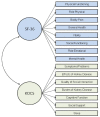Measurement invariance of the kidney disease and quality of life instrument (KDQOL-SF) across veterans and non-veterans
- PMID: 20973987
- PMCID: PMC2984554
- DOI: 10.1186/1477-7525-8-120
Measurement invariance of the kidney disease and quality of life instrument (KDQOL-SF) across veterans and non-veterans
Abstract
Background: Studies have demonstrated that perceived health-related quality of life (HRQOL) of patients receiving hemodialysis is significantly impaired. Since HRQOL outcome data are often used to compare groups to determine health care effectiveness it is imperative that measures of HRQOL are valid. However, valid HRQOL comparisons between groups can only be made if instrument invariance is demonstrated. The Kidney Disease Quality of Life-Short Form (KDQOL-SF) is a widely used HRQOL measure for patients with chronic kidney disease (CKD) however, it has not been validated in the Veteran population. Therefore, the purpose of this study was to examine the measurement invariance of the KDQOL-SF across Veterans and non-Veterans with CKD.
Methods: Data for this study were from two large prospective observational studies of patients receiving hemodialysis: 1) Veteran End-Stage Renal Disease Study (VETERAN) (N = 314) and 2) Dialysis Outcomes and Practice Patterns Study (DOPPS) (N = 3,300). Health-related quality of life was measured with the KDQOL-SF, which consists of the SF-36 and the Kidney Disease Component Summary (KDCS). Single-group confirmatory factor analysis was used to evaluate the goodness-of-fit of the hypothesized measurement model for responses to the subscales of the KDCS and SF-36 instruments when analyzed together; and given acceptable goodness-of-fit in each group, multigroup CFA was used to compare the structure of this factor model in the two samples. Pattern of factor loadings (configural invariance), the magnitude of factor loadings (metric invariance), and the magnitude of item intercepts (scalar invariance) were assessed as well as the degree to which factors have the same variances, covariances, and means across groups (structural invariance).
Results: CFA demonstrated that the hypothesized two-factor model (KDCS and SF-36) fit the data of both the Veteran and DOPPS samples well, supporting configural invariance. Multigroup CFA results concerning metric and scalar invariance suggested partial strict invariance for the SF-36, but only weak invariance for the KDCS. Structural invariance was not supported.
Conclusions: Results suggest that Veterans may interpret the KDQOL-SF differently than non-Veterans. Further evaluation of measurement invariance of the KDQOL-SF between Veterans and non-Veterans is needed using large, randomly selected samples before comparisons between these two groups using the KDQOL-SF can be done reliably.
Figures

Similar articles
-
Negligible impact of differential item functioning between Black and White dialysis patients on the Kidney Disease Quality of Life 36-item short form survey (KDQOLTM-36).Qual Life Res. 2018 Oct;27(10):2699-2707. doi: 10.1007/s11136-018-1879-3. Epub 2018 May 14. Qual Life Res. 2018. PMID: 29761347
-
Comparison of health-related quality of life measures for chronic renal failure: quality of well-being scale, short-form-6D, and the kidney disease quality of life instrument.Qual Life Res. 2008 Oct;17(8):1103-15. doi: 10.1007/s11136-008-9387-5. Epub 2008 Sep 13. Qual Life Res. 2008. PMID: 18791810
-
Psychometric Properties of the Kidney Disease Quality of Life 36-Item Short-Form Survey (KDQOL-36) in the United States.Am J Kidney Dis. 2018 Apr;71(4):461-468. doi: 10.1053/j.ajkd.2017.07.020. Epub 2017 Nov 8. Am J Kidney Dis. 2018. PMID: 29128411
-
Comparisons of quality of life between patients underwent peritoneal dialysis and hemodialysis: a systematic review and meta-analysis.Health Qual Life Outcomes. 2020 Jun 18;18(1):191. doi: 10.1186/s12955-020-01449-2. Health Qual Life Outcomes. 2020. PMID: 32552800 Free PMC article.
-
Do self-report instruments allow meaningful comparisons across diverse population groups? Testing measurement invariance using the confirmatory factor analysis framework.Med Care. 2006 Nov;44(11 Suppl 3):S78-94. doi: 10.1097/01.mlr.0000245454.12228.8f. Med Care. 2006. PMID: 17060839 Free PMC article. Review.
Cited by
-
Negligible impact of differential item functioning between Black and White dialysis patients on the Kidney Disease Quality of Life 36-item short form survey (KDQOLTM-36).Qual Life Res. 2018 Oct;27(10):2699-2707. doi: 10.1007/s11136-018-1879-3. Epub 2018 May 14. Qual Life Res. 2018. PMID: 29761347
-
Intradialytic Activities and Health-Related Quality of Life Among Hemodialysis Patients.Am J Nephrol. 2018;48(3):181-189. doi: 10.1159/000492623. Epub 2018 Sep 3. Am J Nephrol. 2018. PMID: 30176670 Free PMC article.
-
Mapping the kidney disease quality of life 36-item short form survey (KDQOL-36) to the EQ-5D-3L and the EQ-5D-5L in patients undergoing dialysis.Eur J Health Econ. 2019 Nov;20(8):1195-1206. doi: 10.1007/s10198-019-01088-5. Epub 2019 Jul 23. Eur J Health Econ. 2019. PMID: 31338698 Free PMC article.
-
Integrating a Medical Home in an Outpatient Dialysis Setting: Effects on Health-Related Quality of Life.J Gen Intern Med. 2019 Oct;34(10):2130-2140. doi: 10.1007/s11606-019-05154-9. Epub 2019 Jul 24. J Gen Intern Med. 2019. PMID: 31342329 Free PMC article.
-
Quality of life in people with chronic kidney disease: focusing on modifiable risk factors.Curr Opin Nephrol Hypertens. 2024 Nov 1;33(6):573-582. doi: 10.1097/MNH.0000000000001013. Epub 2024 Jul 22. Curr Opin Nephrol Hypertens. 2024. PMID: 39115435 Free PMC article. Review.
References
-
- U.S.Renal Data System. USRDS 2006 Annual Data Report: Atlas of End-Stage Renal Disease in the United States. National Institutes of Health, National Institute of Diabetes and Digestive and Kidney Diseases, Bethesda, MD; 2007. 6-20-2007.
-
- Guerini RD, Mercieri A, Yavuzer G. Multidimensional health-status assessment of chronic hemodialysis patients: the impact on quality of life. Europa Medicophysica. 2006;42:113–119. - PubMed
-
- Al-Arabi S. Quality of life: subjective descriptions of challenges to patients with end stage renal disease. Nephrology Nursing Journal: Journal of the American Nephrology Nurses' Association. 2006;33:285–292. - PubMed
Publication types
MeSH terms
LinkOut - more resources
Full Text Sources
Medical

